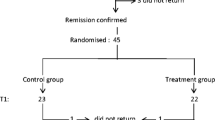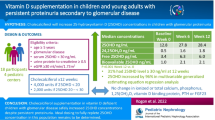Abstract
Background
Cross-sectional studies of children with prevalent nephrotic syndrome (NS) have shown 25-vitamin D (25(OH)D) deficiency rates of 20–100 %. Information on 25(OH)D status in incident patients or following remission is limited. This study aimed to assess 25(OH)D status of incident idiopathic NS children at presentation and longitudinally with short-term observation.
Methods
Multicenter longitudinal study of children (2–18 years old) from 14 centers across the Midwest Pediatric Nephrology Consortium with incident idiopathic NS. 25(OH)D levels were assessed at diagnosis and 3 months later.
Results
Sixty-one children, median age 5 (3, 11) years, completed baseline visit and 51 completed second visit labs. All 61 (100 %) had 25(OH)D < 20 ng/ml at diagnosis. Twenty-seven (53 %) had 25(OH)D < 20 ng/ml at follow-up. Fourteen (28 %) children were steroid resistant. Univariate analysis showed that children prescribed vitamin D supplements were less likely to have 25(OH)D deficiency at follow-up (OR 0.2, 95 % CI 0.04, 0.6). Steroid response, age, and season did not predict 25(OH)D deficiency. Multivariable linear regression modeling showed higher 25(OH)D levels at follow-up by 13.2 ng/ml (SE 4.6, p < 0.01) in children supplemented with vitamin D.
Conclusions
In this incident idiopathic NS cohort, all children at diagnosis had 25(OH)D deficiency and the majority continued to have a deficiency at 2–4 months. Supplemental vitamin D decreased the odds of 25(OH)D deficiency at follow-up, supporting a role for supplementation in incident NS.
Similar content being viewed by others
References
(1978) Nephrotic syndrome in children: prediction of histopathology from clinical and laboratory characteristics at time of diagnosis. A report of the international study of kidney disease in children. Kidney Int 13:159–165
Gipson DS, Massengill SF, Yao L, Nagaraj S, Smoyer WE, Mahan JD, Wigfall D, Miles P, Powell L, Lin JJ, Trachtman H, Greenbaum LA (2009) Management of childhood onset nephrotic syndrome. Pediatrics 124:747–757
Freundlich M, Bourgoignie JJ, Zilleruelo G, Abitbol C, Canterbury JM, Strauss J (1986) Calcium and vitamin D metabolism in children with nephrotic syndrome. J Pediatr 108:383–387
Freundlich M, Bourgoignie JJ, Zilleruelo G, Jacob AI, Canterbury JM, Strauss J (1985) Bone modulating factors in nephrotic children with normal glomerular filtration rate. Pediatrics 76:280–285
Grymonprez A, Proesmans W, Van Dyck M, Jans I, Goos G, Bouillon R (1995) Vitamin D metabolites in childhood nephrotic syndrome. Pediatr Nephrol 9:278–281
Weng FL, Shults J, Herskovitz RM, Zemel BS, Leonard MB (2005) Vitamin D insufficiency in steroid-sensitive nephrotic syndrome in remission. Pediatr Nephrol 20:56–63
Wetzsteon RJ, Shults J, Zemel BS, Gupta PU, Burnham JM, Herskovitz RM, Howard KM, Leonard MB (2009) Divergent effects of glucocorticoids on cortical and trabecular compartment BMD in childhood nephrotic syndrome. J Bone Miner Res 24:503–513
Kumar J, Muntner P, Kaskel FJ, Hailpern SM, Melamed ML (2009) Prevalence and associations of 25-hydroxy vitamin D deficiency in US children: NHANES 2001–2004. Pediatrics 124:e362–370
Mansbach JM, Ginde AA, Camargo CA Jr (2009) Serum 25-hydroxy vitamin D levels among US children aged 1 to 11 years: do children need more vitamin D? Pediatrics 124:1404–1410
Saintonge S, Bang H, Gerber LM (2009) Implications of a new definition of vitamin D deficiency in a multiracial us adolescent population: the National Health and Nutrition Examination Survey III. Pediatrics 123:797–803
Banerjee S, Basu S, Sengupta J (2013) Vitamin D in nephrotic syndrome remission: a case–control study. Pediatr Nephrol 28:1983–1989
Goldstein DA, Oda Y, Kurokawa K, Massry SG (1977) Blood levels of 25-hydroxy vitamin D in nephrotic syndrome. Studies in 26 patients. Ann Intern Med 87:664–667
Lambert PW, De Oreo PB, Fu IY, Kaetzel DM, von Ahn K, Hollis BW, Roos BA (1982) Urinary and plasma vitamin D3 metabolites in the nephrotic syndrome. Metab Bone Dis Relat Res 4:7–15
Dickson LE, Wagner MC, Sandoval RM, Molitoris BA (2014) The proximal tubule and albuminuria: really! J Am Soc Nephrol 25:443–453
Forman JP, Curhan GC, Taylor EN (2008) Plasma 25-hydroxy vitamin D levels and risk of incident hypertension among young women. Hypertension 52:828–832
Larsen T, Mose FH, Bech JN, Hansen AB, Pedersen EB (2012) Effect of cholecalciferol supplementation during winter months in patients with hypertension: a randomized, placebo-controlled trial. Am J Hypertens 25:1215–1222
Swales HH, Wang TJ (2010) Vitamin D and cardiovascular disease risk: emerging evidence. Curr Opin Cardiol 25:513–517
Lac PT, Choi K, Liu IA, Meguerditchian S, Rasgon SA, Sim JJ (2010) The effects of changing vitamin D levels on anemia in chronic kidney disease patients: a retrospective cohort review. Clin Nephrol 74:25–32
Zold E, Szodoray P, Kappelmayer J, Gaal J, Csathy L, Barath S, Gyimesi E, Hajas A, Zeher M, Szegedi G, Bodolay E (2010) Impaired regulatory T-cell homeostasis due to vitamin D deficiency in undifferentiated connective tissue disease. Scand J Rheumatol 39:490–497
Leonard MB, Zemel BS (2002) Current concepts in pediatric bone disease. Pediatr Clin N Am 49:143–173
Gulati S, Godbole M, Singh U, Gulati K, Srivastava A (2003) Are children with idiopathic nephrotic syndrome at risk for metabolic bone disease? Am J Kidney Dis 41:1163–1169
Leonard MB, Feldman HI, Shults J, Zemel BS, Foster BJ, Stallings VA (2004) Long-term, high-dose glucocorticoids and bone mineral content in childhood glucocorticoid-sensitive nephrotic syndrome. N Engl J Med 351:868–875
Hegarty J, Mughal MZ, Adams J, Webb NJ (2005) Reduced bone mineral density in adults treated with high-dose corticosteroids for childhood nephrotic syndrome. Kidney Int 68:2304–2309
Choudhary S, Agarwal I, Seshadri MS (2014) Calcium and vitamin D for osteoprotection in children with new-onset nephrotic syndrome treated with steroids: a prospective, randomized, controlled, interventional study. Pediatr Nephrol 29:1025–1032
Bak M, Serdaroglu E, Guclu R (2006) Prophylactic calcium and vitamin D treatments in steroid-treated children with nephrotic syndrome. Pediatr Nephrol 21:350–354
Gulati S, Sharma RK, Gulati K, Singh U, Srivastava A (2005) Longitudinal follow-up of bone mineral density in children with nephrotic syndrome and the role of calcium and vitamin D supplements. Nephrol Dial Transplant 20:1598–1603
Papandreou D, Malindretos P, Karabouta Z, Rousso I (2010) Possible health implications and low vitamin D status during childhood and adolescence: an updated mini review. Int J Endocrinol 2010:472173
Huang JP, Bai KM, Wang BL (1992) Vitamin D and calcium metabolism in children with nephrotic syndrome of normal renal function. Chin Med J (Engl) 105:828–832
Biyikli NK, Emre S, Sirin A, Bilge I (2004) Biochemical bone markers in nephrotic children. Pediatr Nephrol 19:869–873
Freundlich M, Jofe M, Goodman WG, Salusky IB (2004) Bone histology in steroid-treated children with non-azotemic nephrotic syndrome. Pediatr Nephrol 19:400–407
Acknowledgments
The investigators are indebted to the children and families who graciously participated in this study. This work was supported by a grant from the Renal Research Institute. M.E.S. was supported by the Washington University Institute of Clinical and Translational Sciences grants UL1 TR000448 and KL2 TR000450 from NIH/NCATS, and L40 DK099748 from NIH/NIDDK. The content is solely the responsibility of the authors and does not necessarily represent the official views of the NIH.
Conflict of interest
The author(s) declare that they have no competing interests.
Author information
Authors and Affiliations
Corresponding author
Ethics declarations
Each site obtained individual institutional IRB approval. Parents and children gave informed consent and assent respectively.
Rights and permissions
About this article
Cite this article
Selewski, D.T., Chen, A., Shatat, I.F. et al. Vitamin D in incident nephrotic syndrome: a Midwest Pediatric Nephrology Consortium study. Pediatr Nephrol 31, 465–472 (2016). https://doi.org/10.1007/s00467-015-3236-x
Received:
Revised:
Accepted:
Published:
Issue Date:
DOI: https://doi.org/10.1007/s00467-015-3236-x




